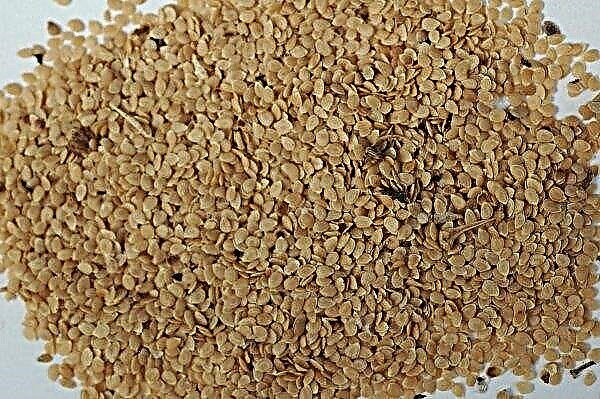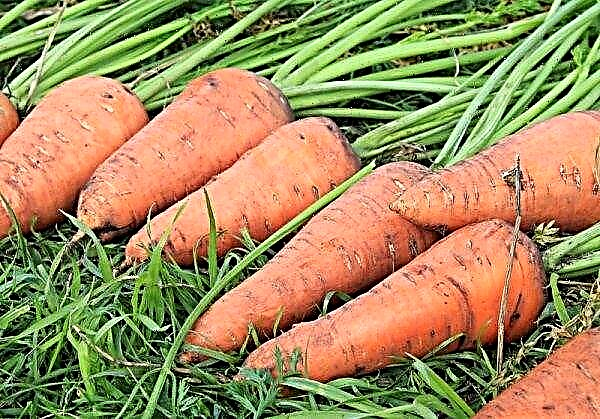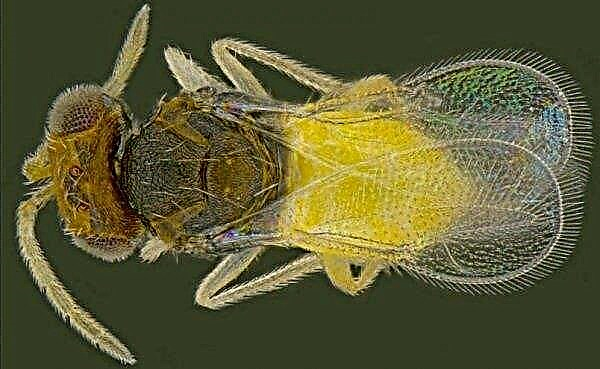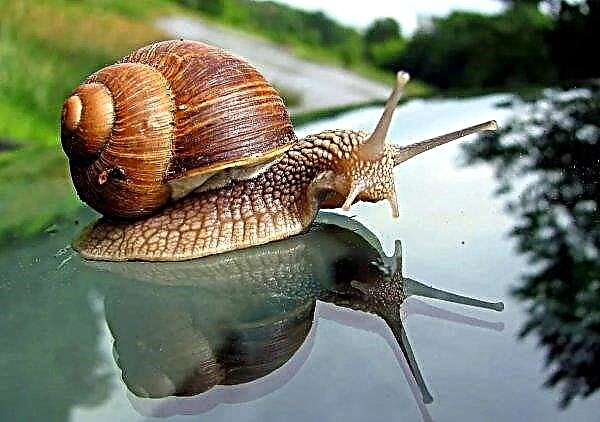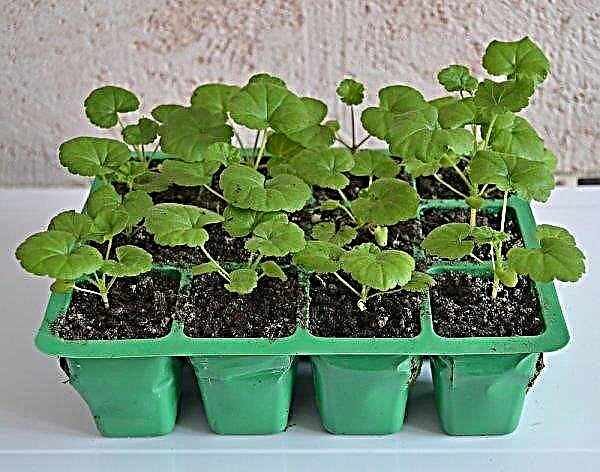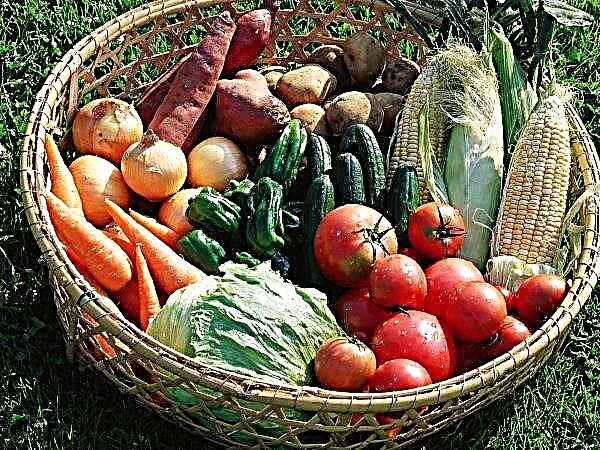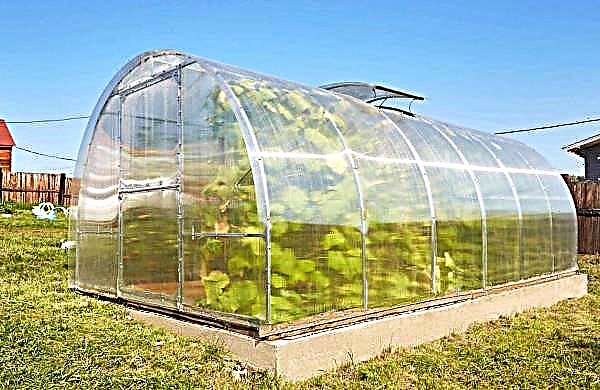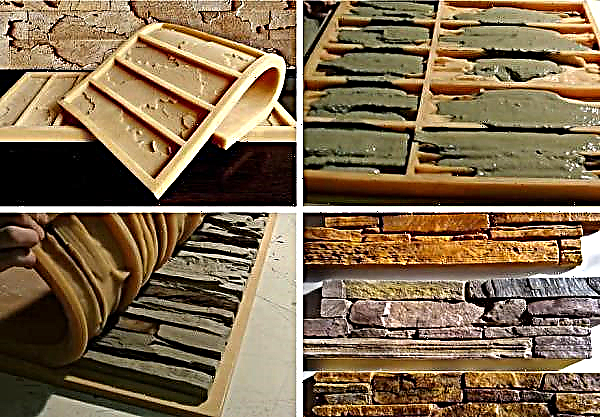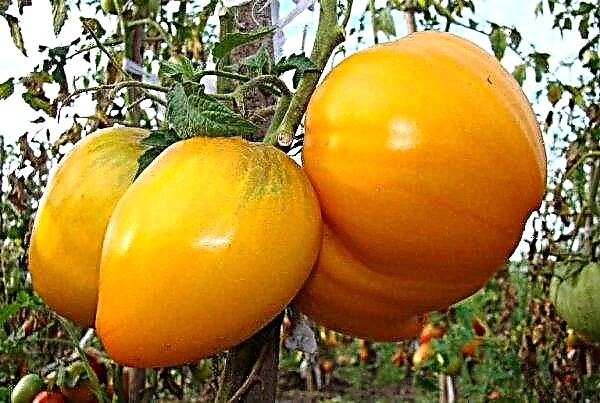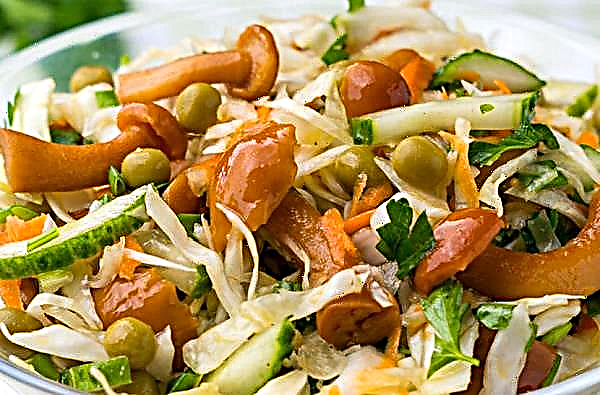When spring is just around the corner - it's time to choose what kinds of pepper to grow on the site. You might like round pepper Novogogoshara. About him and will be discussed in this review.
Description and characteristics of the variety
Novogogoshary is a member of the Solanaceae family. A distinctive feature is the pumpkin-shaped fruit shape, characteristic of the entire group of the Gogoshary variety. Ripening occurs on 110–115 days, which allows attributing Novogogoshary to early ripening varieties. Pepper is suitable for cooking, preserving (round fruits are recommended to pickle whole).
The bush belongs to the standard, medium-sized and reaches a height of 0.5 m. Therefore, it is often grown in open ground than in a greenhouse. The variety is demanding on heat and soil nutrition. Suitable for outdoor cultivation in the southern regions. In the northern regions, they prefer growing Novogogoshar under a film: in a greenhouse or greenhouse. The variety is characterized by excellent appearance, portability and good keeping quality.
Did you know? Pepper is considered the first domesticated wild plant. Seeds found in Mexico and Peru for more than 6000 years. They are found on ancient cooking tools.
Selection history
In the Moldavian Research Institute, in the Soviet period, a group of round varieties of pepper, Gogoshara, was developed. A characteristic feature of the group is a shape resembling a pumpkin. Fruits with a pleasant taste and unpretentiousness to the growing conditions. Variety Novogogoshary - an improved version of the predecessors of the series. The main feature of the new variety is the absence of bitterness.
Productivity
The total yield is about 4 kg per 1 m². There are 6–7 fruits per Novogogoshar bush. Ripening occurs in several stages, so you can count on harvesting 2-3 times from each bush during the growing season.

Description of the fetus
Novogogoshary are rounded flattened fruits of red color. The mass of the fruit is 90–150 g. The pepper is sweet, fleshy, with a dense skin. The thickness of its wall reaches 1 cm. It is characterized by excellent taste and aroma.
Advantages and disadvantages of the variety
- The variety has the following advantages:
- fleshy large fruits;
- good yield;
- high transportability and durability;
- pleasant taste;
- the possibility of using raw and cooked.
- The disadvantages of the variety:
- demanding on air temperature and soil nutrition;
- shows the best yield when grown in a greenhouse, although the height of the bush is impractical for her;
- fragility of the root system.
Features of the technique of growing culture
You can plant pepper in the ground with seeds in the southern regions. In other regions, this is done in a seedling method, starting to grow seedlings 8–10 weeks before planting in the ground. You can move it to the beds 2-3 weeks after the last spring freeze. For pepper, you need a sunny area with nutritious loose soil.

Seed treatment
Seeds will need treatment from bacteria and stimulation of development.
To do this, follow these steps:
- Treat healthy seeds with hot water (+ 60 ° C) for 5–10 minutes. for the purpose of disinfection. You can warm up under the lamp at the same temperature.
- Treat with sodium humate during the day at a solution temperature of + 25 ° C. By treating seeds with a growth stimulator, farmers increase the percentage of seed germination, ensure even development of plants, neutralize pathogenic microorganisms, improve plant endurance and their resistance to diseases.
- Treat the seeds with Azotofit. The solution is prepared at the rate of 5 ml per 0.5 l of water and the planting material is treated for 2 hours. The drug activates the activity of nitrogenous bacteria, which heals the seeds and creates a partial antibacterial effect.
Did you know? The acids included in Gogoshar suppress the activity of the nervous system, helping to fight insomnia and improving mood with autumn spleen.
The selection of containers for seedlings
Tanks of different sizes and materials are suitable for growing Novogogoshar. Often use wooden boxes, containers for yogurt and others.
For growing seedlings on sale are:
- special cassettes;
- peat glasses;
- peat tablets.
Peat tablets are the most convenient and practical. They are compressed peat, packed in a mesh shell. When a tablet is saturated with moisture, it swells to the size of a cylinder. A seed sprouts in it, and the plant develops until the moment of a dive or transplant. An overgrown plant is planted with a tablet. This is an important advantage of this material, since the roots of the pepper are brittle and can be damaged during transplantation.

Preparing land for seedlings
The soil mixture for pepper can consist of peat soil and sod land 2: 1. Peat can be replaced with humus. If the site is dense, clayey soil, you can add it to the soil mixture. So you create conditions similar to natural for the roots and form a stronger root system.
A mixture of:
- 1/3 of good garden soil (not clay, because it is dense);
- 1/3 rotted cow manure;
- 1/3 sand for loosening the soil.
Before planting the seeds, the soil is disinfected with hot water or high temperature. Watering with a weak solution of potassium permanganate (3%) performs an antibacterial function.

Sowing seeds
Most pepper seeds germinate after about a week at a temperature of +21 ... + 26 ° C. To sprout seeds faster, they are germinated by placing them in a warm place under wet gauze or in a paper towel. The towel is wrapped in polyethylene to reduce the evaporation of moisture and increase the temperature of the air around the seeds.
As soon as the seeds germinate, they are carefully planted in separate containers. The optimal conditions for seedling growth are on the southern windowsill. Pepper needs sun and heat. Here plants can be located before planting in the ground. Do not plant seedlings until the night temperature rises above +12 ... + 15 ° С.
If the seeds are grown in peat tablets, they should first be moistened, in each plant 1-2 seeds and put in a plastic container. Cover the container with foil to create optimal air temperature and humidity. This will accelerate germination by 2-3 days.
Important! When planting pepper seeds on seedlings, be patient. Some varieties emerge after 4–6 weeks, and others will appear in 7–10 days. It also depends on temperature, sunlight, soil quality.
Features seedlings care
Caring for Novogogoshary includes:
- creating optimal conditions for growth;
- dive;
- frequent watering;
- periodic fertilizer of the soil.
Set containers with seedlings on a light windowsill. For germination, the containers are covered with a film to create high humidity and air temperature for rapid germination of seeds. So that the seedlings do not stretch, the temperature should be +16 ... + 18 ° C. Water as the soil dries, but at least 1 time per week. Pepper does not like dryness, so do not let it dry.
In a phase of 2-3 true leaves, seedlings dive. To do this, a pointed skewer is introduced into the soil and the plant is gently poked. The lower part of the root is trimmed to enhance the development of peripheral roots. Plant a seedling in a separate glass.
When grown in peat tablets, the plant does not dive or fertilize. When grown in the ground 2 weeks after emergence, the seedlings are fed. To do this, prepare an aqueous solution of urea, superphosphate and water (1 g / 6 g / 2 l). 3 days before transplanting seedlings into the ground Novogogoshary must be fed a second time.
Important! If sweet and hot pepper varieties are planted nearby, there will be a pollination, as a result of which, sweet pepper will taste bitter!
Planting seedlings in the soil
2 weeks after the last freezing, Novogogoshar seedlings can be planted in the ground. The air temperature should not fall below +12 ... + 14 ° С.
Landing Instructions:
- Dig a bed, mixing the soil with rotted manure (2 buckets per 1 m² of soil).
- Prepare the pits for planting at a distance of 20 cm from each other. During growth, pepper is preferable to thickening, so it makes no sense to plant them at a longer distance.
- Carefully remove the pepper from the container in which it grew. If the seedlings are in peat glasses (tablets), they can be planted without removing them from the tank.
- Pour 0.5–1 L of water into each well.
- Install the sprouts in the recess and sprinkle with soil.
- Pull the soil to avoid air pockets.
- Mulch seedlings with straw, spruce branches or other materials to preserve moisture in the soil and prevent weed growth.
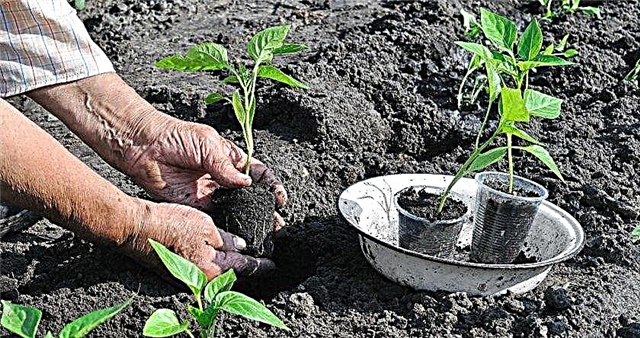
Care after planting seedlings in the ground
Having planted seedlings in the ground, you must take care of:
- periodically pruning and forming bushes;
- garter;
- watering;
- fertilizer application.
Also carry out loosening, removing weeds, hilling.
Pruning Novogogoshar will be needed to reduce the degree of thickening of the bushes. If a plentiful crown impedes air circulation, in hot and humid weather conditions are created for the development of late blight and other diseases.
Pepper loves sunny areas. But in order to avoid sunburn in the summer, it is advisable to choose a site on which the intensity of lighting changes during the day.
Important! All varieties of Gogoshar are extremely sensitive to heat. The optimum temperature for their development — +25°C. Its decrease of 5 degrees causes a lag in the development and maturity of the crop.
Watering and feeding
Too frequent and intense watering is harmful to peppers: water flushes nutrients deep into the soil and creates the conditions for the growth of pathogenic microorganisms.
Before watering, make sure that the top of the soil (5 cm) is dry. When watering, you need to soak the soil to a depth of 10-15 cm - this is the length of the root system of the plant. Depending on weather conditions, watering is carried out 2-3 times a week.
The first top dressing is carried out when the seedlings are planted in the ground. Then, in the flowering phase or at the moment when small fruits form on the bushes. For root top dressing, organic and synthetic fertilizers can be used. More often, gardeners give preference to the second type, because their volume is easier to measure and avoid overdose.
For typical top dressing, use:
- potassium - 30 g;
- ammonium nitrate - 15 g;
- superphosphate - 50 g.
Dissolve the components in 10 l of water and add 1 l to the root zone of each bush.

Hilling and loosening the soil
Loosening the soil does not affect the yield, but contributes to the development of the root system, and thereby the plant itself. Loosening is necessary on the second day after watering, when the earth dries. Weeds are weeding at the same time. If mulch materials are used, they inhibit weed growth and soil compaction. In this case, weeding and loosening are not needed.
On the need for hilling pepper there are two opposite points of view. Opponents of the procedure rely on the fact that pepper does not form tubers, unlike potatoes, so hilling is not a mandatory procedure.
Supporters talk about the following features:Did you know? The most useful for the body are red varieties of sweet pepper. Their nutritional value is higher than that of green varieties.
- The root system of pepper is not very large. A ripening crop makes the upper part of the bush heavier, which leads to deformation of the trunk, and under a gust of wind it can cause a plant to fall. Therefore, hilling allows the pepper to develop roots and better maintain weight.
- An alternative to hilling can be tying the plant to a peg, especially if there are large peppers on the bush.
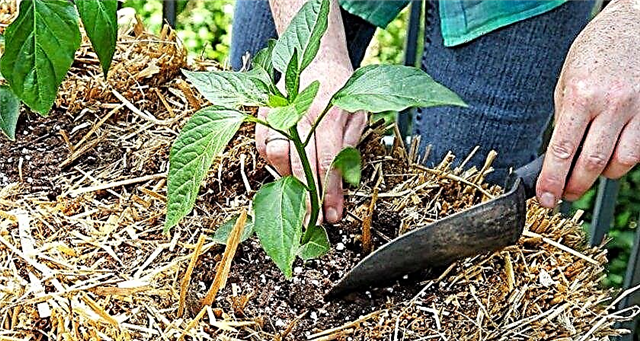
The formation of pepper bushes
Pruning Novogogoshar is carried out at the beginning of the growing season, it improves the quality of the fruit. Autumn pruning accelerates the ripening of the crop remaining on the bushes.
Trimming Instructions:
- Look at the two main branches of pepper. They resemble the letter “Y” with a lower stem and two main branches. These are the branches on which the fruits will form.
- Visually move along the main branch to the first small branch departing from it. Use sharp scissors to remove it.
- Move higher. Count out 3 more side shoots and remove the third.
- Continue to cut off every third side branch on the main branch, alternating the outer and inner side branches.

Pest and Disease Control
Part of the pathogenic microflora penetrates into plant tissues through places damaged by insects. Therefore, farmers use insect traps to spot pests and take action in time. The habitats of most sucking insects are on the underside of the leaves, in the sinuses and folds. Some insects are too small to be noticed.
The main pests of Gogoshar are aphids. They suck vegetable juice, leaving a sticky coating on the leaves, on which soot fungi develop, infecting peppers. The fight against aphids consists in spraying plants with a soap solution. Peppers are also sprayed with "Fosbetsidom" (5 ml of the drug in 5 l of water). Pay attention to the difference in dosage when spraying different crops.
Peppers infect the same insects as potatoes, tomatoes or eggplant. If next to your garden there is a plot with potatoes - you will come across a Colorado potato beetle. Against a bug apply spraying with the preparations "Aktara", "Prestige".
Gogosharas are resistant to disease. They rarely suffer from late blight, powdery mildew or gray rot. Excessive humidity at high air temperature, insect pests become the provoking factors of the disease.
Precautionary measures:
- Planting plants to ensure good air circulation.
- Observe crop rotation.
- Remove the affected parts of the plant, and then treat the crops with a solution of copper sulfate 3%.
- In case of detection of signs of disease, treat with a wide spectrum of fungicides that will help in most cases: when infected with scab, bacteriosis, powdery mildew, fungi, late blight and other diseases. The most commonly used drugs are Fitosporin-M, Gamair, Alirin-B. Dilute solutions should be strictly according to the instructions, since the dosage may vary depending on the type of disease.
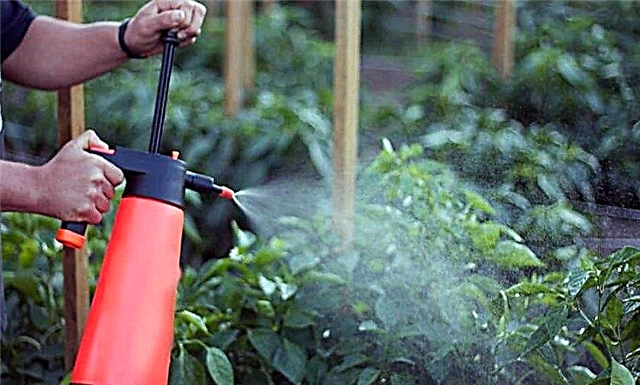
Features of harvesting and storage of crops
Pepper Harvesting Rules:
- Collect the pepper as soon as the fruit reaches the desired size.
- Use a sharp knife or pruner to cut the fruit with the least damage to the plant. If you pull peppers, trying to remove them, you can break the branches.
- It is believed that the longer sweet pepper is stored on the bushes, the more sweetness it acquires.
Pepper can be stored in the refrigerator for 7–10 days or at + 7 ° C and a relative humidity of 85–90%. It can be used in soups and salads, as well as for winter preparations. Peppers cannot be stored fresh outside the refrigerator.
It’s not difficult to care for the Novogogoshara variety, and even easier than for other vegetables. But each culture requires compliance with the rules for caring for it.And if you follow them, you will get an excellent harvest in the fall of unusual in shape and sweet fruit.Network user reviews
The variety is quite interesting, the shape is in the form of a flattened round barrel, it is extremely fragrant and very tasty. The bush is low (50 cm), so planting in a greenhouse is irrational, more convenient in film tunnels. The stem is thick, the bush is strong, semi-spreading. Fruits in technical ripeness are dark green and quite tasteless, you need to wait for biological ripening. The wall is thick, fleshy, sometimes reaching 1 cm. But there are few peppers formed on one plant, only 6-7 pieces, they say you can wait for the second and even third waves of fruiting, but in our Siberian conditions this is unrealistic. This variety is demanding on top dressing and must be formed .
http://www.bolshoyvopros.ru/questions/1932139-perec-sladkij-novogogoshary-otzyvy.html#answer7071553




